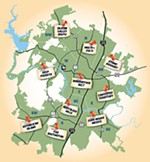Geopolitical Fault Lines
Austin's latest attempt at single-member districts is getting a mixed response
By Josh Rosenblatt, Fri., July 6, 2012

Austin City Council inauguration ceremonies don't generally include political speeches. Newly elected or re-elected council members, flush with the good will and generosity of spirit that only seems to mark the human character after a victory, generally set aside ideology for an hour and reserve their short remarks for thanking campaign staffs, recognizing family members, and listing a few boilerplate issues they look forward to tackling during their terms – say, poverty, or the environment. Otherwise, it's all pomp and circumstance: Invocations are delivered, oaths are taken, bagpipes blare, the national anthem is sung, and everyone retreats to the lobby for cookies and lemonade.
So it came as something of a surprise at last week's swearing-in ceremony that Mayor Lee Leffingwell took the occasion not only to declare his plan for a hybrid geographic representation system, but also to criticize the single-member plan favored by at least two of his council colleagues. Foregoing the ceremonial niceties, Leffingwell described his plan as "much-needed reform" while decrying the 10-1 plan proposed by Mike Martinez and Sheryl Cole as "worse than the exclusively at-large system we have today."
"District-based representation is something we badly need, but we have to be very careful that we don't trade bad for worse," Leffingwell said. "A mixed system of representation, one that incorporates a mix of representatives from districts and citywide representatives, is the best choice for Austin. I believe a mixed system would allow for a fair balance of interests ... elevating neighborhood-level concerns without abandoning citywide perspectives. For this reason, I do not believe that transitioning to a council made up exclusively of district representatives would be good for Austin."
Maybe it wasn't such a surprise. After all, when you're trying to change the way your city conducts the business of electing its leaders, things are bound to get a little testy. As members headed into their meeting last Thursday (their last before the annual monthlong recess), the issue of geographic representation had reached not only a fever pitch of council and civilian discontent but also what Council Member Bill Spelman once called the level of "maximum feasible misunderstanding." Two competing plans for dividing up the city electorally were on the agenda, competing for a place on the November charter revision ballot (along with numerous adjunct provisions that would move council elections to November, extend council terms to four years, stagger those terms every two years, etc.). There was also a third plan, supported and signed by some 30,000 private citizens, hanging ominously over the proceedings, a reminder of the mess to come once that day's mess had been sorted out.
By the end of Thursday's meeting, a messy situation had grown into a completely different kind of municipal beast. Martinez changed his proposal at the last minute to mirror plan No. 3 ("the people's plan"), three members voted to put both Martinez's and Leffingwell's proposals on the November ballot (leaving it to the voters to slug it out), and one member voted to leave both plans for geographic representation off the ballot entirely in the name of ... getting geographic representation on the ballot (see "Council Math: 1 + 1 = ?").
If democracy isn't easy, then remaking a democracy is really, really not easy.
If You're Black, Stay Back
Austin's current at-large council system was conceived in racism. During most of the first half of the 20th century, the city had a single-ballot plurality system, under which the top five vote-getters on a single ballot became council members. There were no places and no run-offs, and council members served the entire city. But in 1951, Austin NAACP's then-President Arthur DeWitty finished sixth in the City Council race, just barely missing the coveted fifth place. That potential outcome scared the hell out of the white business establishment, which promptly drew up a charter revision that would abolish the single-ballot system and replace it with a system of designated places requiring 50% of the vote plus one to win – a majority no black candidate in the Fifties in Texas could ever hope to achieve. That charter revision, stoked by racist sentiment in the press, was enacted in 1953.
It would be 14 years before another black person even ran for council. Since 1973, advocates have tried to change the Austin electoral system into some kind of geographic representation six times – arguing that it would increase minority representation, voter participation, and general electoral fairness – and six times they've failed. And if they're not careful (indeed, perhaps even if they are), they're going to fail again.
'The People' Speak
If nothing else, single-member advocacy makes for strange bedfellows.
Take Austinites for Geographic Representation, the grassroots group that has become the flag-bearer of the 10-1 single-member plan. AGR's 10-1 single-member plan, which was born in response to the now-disbanded 2012 Charter Revision Committee appointed by council last year, has been endorsed by one of the strangest coalitions the city has ever seen. It takes nothing short of a miracle to get the Austin Police Association and Texans for Accountable Government (a group that spends much of its time and energy protesting against what it considers Austin Police Department abuses) to see eye-to-eye on anything. Yet there they are, on the AGR's endorsement page, kept apart only by the conspiracy of alphabetical order. The police association and the NAACP? That pairing is on there too. The Travis County Republican Party and the South Austin Democrats? Busy beating swords into plowshares together.
AGR spokeswoman Jessica Ellison says longtime frustration with the at-large system, coupled with the populist virtues of the 10-1 plan – under which the council would be made up of 10 district representatives and one at-large mayor – have generated this odd coalition. "We believe the 10-1 plan is the plan the people want, not the plan special interests want," she says. "The Charter Revision [Committee] voted in favor of the 10-1 plan, and we support it because it's the only plan that actually puts the power in the citizens' hands. In a single-member system, council members will be held accountable by their constituents."
As if to amplify the "people-first" spirit of the 10-1 plan, AGR members have been collecting signatures since March on a petition to get the plan on the ballot this November as a charter amendment. Under city law, in order to qualify for the ballot, all petitions must have at least 20,000 valid signatures. Last Thursday, coinciding with the scheduled City Council public hearing, AGR representatives delivered seven boxes' worth of signatures to City Hall, for eventual counting and validation by staff – if they decide the council version of their proposal is insufficient.
That's one way to get a plan on the ballot. The other way is to get the support of council members themselves. You may need the names of 20,000 voters with a petition, but it only takes four council members. That's the approach taken by the newly formed Austin Community for Change.
AC4C also spun off indirectly from the CRC, but it represents the other side of that group's 8-7 vote, the side that endorsed geographic districts tempered by some at-large representation. (Disclosure: Susan Moffat, spouse of Chronicle Publisher Nick Barbaro, is a founding member of AC4C.) Under the plan the group is advocating (and which Leffingwell and council members Morrison, Riley, and Tovo supported at last Thursday's meeting), council would be made up of eight district representatives, two at-large members, and one at-large mayor. Their arguments in favor of the 8-2-1 plan are essentially twofold. On the one hand, they say their plan will lead to more fairness, particularly for minority constituencies – including Asian-Americans, African-Americans, and the GLBT community – that are geographically dispersed and therefore may not benefit from a strictly single-member system. (Representatives of the Asian-American community, in particular, pressed that case on and off the CRC.) Moreover, they say, a hybrid plan will lead to more choices for voters, as citizens will be able to vote for four council members under the 8-2-1 plan, but only two under 10-1.

The fact that the 8-2-1 plan has been promoted in part as a result of the efforts of longtime members of the city's political establishment – like consultant David Butts, former State Rep. Ann Kitchen, longtime civic activist Ted Siff, and neighborhood activist Fred McGhee* – while the 10-1 plan arrived there via the signatures of 30,000 "regular folks," has led to accusations by some AGR advocates that the 8-2-1 vs. 10-1 fight is a classic case of "political insiders" defying "the will of the people." "I see no organized support in the general public for another proposal [other than 10-1]," former CRC member Fred Lewis said during last week's council work session. "I do see support within the political elite class for different attitudes and perspectives, but with the public itself, the only proposal that has broad-based support is a 10-1 plan."
It's not unreasonable to point out the discrepancy between a group that managed to get 30,000 signatures in support of its proposal, and a second group that only had to convince four council members of the value of theirs. That said, it's also worth remembering that the mayor and council members are in fact the representatives elected by the voters to determine public policy for the city. Moreover, 8-2-1 supporters are quick to point out that getting people to sign a petition to get a proposal on the ballot isn't the same as getting them to support that proposal once it's there. "The right to be on the ballot is not the same as demonstrating a majority, and it's not a substitute for voters voting," Kitchen told the Chronicle. "The fact of a petition does not negate voters' rights or council's responsibilities. The democratic approach is to allow another option. People should have a choice."
Kitchen's AC4C colleague Richard Jung, meanwhile, argues that despite AGR's petition success and the group's claim that they "speak for the people," the hybrid plan has broad support among the city's rapidly growing, but geographically dispersed, Asian population. And he thinks it's more electable. "They [AGR] got out first and made more noise," Jung says, "but if you put at-large against 10-1, at-large is likely to win. If you put at-large against the hybrid, the hybrid is likely to win."
Drawing the Line-Drawers
In case the differences and suspicions between the supporters of pure single-member districts and the supporters of the hybrid system aren't sufficiently threatening to the electoral viability of either form of geographic representation, the issue of who will be drawing the district lines is probably more than enough to teeter the ship. AGR has made an Independent Citizens Districting Commission the centerpiece of its plan and a central part of its petition. "It's important [that] citizens have the say on drawing the lines," says spokeswoman Jessica Ellison.
Among many uncertainties in the complex provisions that would establish the AGR commission, critics point often to the eligibility restrictions AGR has placed on participation. In an effort to open the political process up to citizens who may not have participated before, and to close it to those who have made politics a career, the AGR plan would (among other restrictions) not allow anyone on the commission who has been a candidate for city or state office in the last five years, served as a political consultant within the last five years, or even contributed or bundled $1,000 or more in aggregate to candidates in the last city election.
AGR says those standards will keep politics out of the redistricting process. "The restrictions are on people who have or have had a vested interest in where those lines are drawn," Ellison says. However, detractors say it will ban vital input as well. "I support the concept of an independent commission, but a lot of the requirements for eligibility are problematic," Leffingwell says. "Maybe they don't have to be so stringent. Basically anyone who's ever served on a board or commission isn't eligible. I don't understand the reason for excluding those people."
Even Council Member Martinez – who originally proposed a 10-1 plan without a citizens commission before amending his proposal last Thursday to essentially mirror the AGR proposal – expressed doubt at last week's work session that the commission would be legally defensible, and more specifically that it would be possible to keep "politics" out of its makeup. "I honestly don't believe it's apolitical. As a matter of fact, I think it's filled with politics," Martinez said. "If we do this in a random process, as is proposed [by AGR], what happens when everyone gets selected east of I-35, or, more likely, everybody's west of I-35? Politics really will come into play. And they'll come to us and they'll want us to fix it."
Council Member Bill Spelman worries that excluding longtime political players is unnecessarily punitive and could result in a commission that isn't informed enough or engaged enough to come up with the best possible district lines. "If you get 14 people who have not been intimately involved with local politics, they will walk in with the best intentions and very little information as to how things really work," Spelman says. "The people who really want to participate in this stuff are not political virgins. The vast majority of people interested in where the lines go are going to be people involved in city politics, and we're eliminating all those people. I'm not sure we can find 14 people who are going to be willing to spend the kind of time involved in all those public hearing and all those meetings to draw districts for something they have never shown any previous interest in." Defending the plan to council during its work session, AGR's Fred Lewis dismissed those concerns by pointing to the "thousands" who volunteered to serve on California's state districting commission, on which the AGR proposal is based. "There will be no shortage of applicants," Lewis insisted.
Ellison says it's just that kind of thinking by public officials that proves an independent commission is needed. "What's made those people not participate in city government?" she asks. "Are we saying those people don't care, that they're not smart enough? Or is it that there's no reason to go to the polls to vote for someone who doesn't represent you? I think they're not participating because the process has left them out and continues to leave them out."
Political Arithmetic
Regardless of how you feel about the virtues of 10-1 vs. 8-2-1, regardless of the concerns you might have about the ability of 10-1 to adequately represent the interests of the entire city, or of 8-2-1 to create a system wherein the people, not "special interests" that can fund the campaigns of at-large candidates, are truly represented, when it comes down to it, the issue is as basic as it gets: Which proposal can win? And will having two propositions on the ballot in November doom both?
Ask political consultant (and 8-2-1 advocate) David Butts, and he'll tell you that numerous polls of November general election voters bear out Richard Jung's claim: that when given a choice between a single-member system, a hybrid system, and the status quo, roughly 35% of Austinites like things the way they are, 35% would prefer a hybrid, and 25% want a pure single-member system. To hybrid advocates, those numbers prove that their proposal has a better chance of passing and therefore should not be kept off the ballot in the name of a "citizen insurgency." AGR supporters, meanwhile, interpret those numbers (if they acknowledge them at all) as proof that the push by political elitists for a hybrid plan will blow up the chances for any geographic-representation system getting 50% of the vote come November, nullifying the will of "the people."
To Butts, the AGR petition doesn't mean much. "It's a way of saying they don't like what we have," he says. "Does that mean they're all going to vote for 10-1? I don't think so. I just think they're discontented with the political system as it's set up right now. Give me enough time, and I think I can turn half of them to the hybrid system."
There are some in the pro-single-member camp who suggest that the longtime political consultant, who helped elect every single member of the current City Council, is gaming the system by pushing for the 8-2-1 proposal, knowing that two plans on the ballot will likely result in neither plan getting enough votes to pass, thereby assuring the retention of the status quo – a status quo that has done well by David Butts. It's a theory that might be backed up by a claim Butts himself made. "Put two proposals on the ballot and I have a suspicion it makes it very difficult for either one to pass," he told the Chronicle two weeks ago, just before lobbying council to put two proposals on the ballot. "But stranger things have happened," he adds.
Butts points to the fact that he's worked in the campaigns for all six previous single-member charter amendment initiatives as proof of the sincerity of his belief in geographic representation. But will of the people or no, he says, 10-1 won't actually have the positive effect on black representation AGR says it will, because the group is misreading the numbers and misunderstanding the politics. By pushing for a single "African-American opportunity district" in Northeast Austin that increases the percentage of potential black voters by decreasing the percentage of potential white voters, he says, they're actually diminishing the chances for continued African-American representation on council.
"The greatest threat to the black seat is not from the Anglos; it's from the Hispanics," Butts says. "They're the fastest-growing population. If you want to keep black representation in that area, don't cut white folks out; keep them in. The 10-1 plan basically draws the white voters out of that opportunity district, which is bad. You need white voters to combine with black voters. The black community's political future relies on building coalitions with other voters. That's why 10-1 is not good for blacks."
"All politics is a math problem," Butts says. "Those who subtract, lose. Those who add, win."
* In the print version of this story, McGhee was listed as an affiliate of the Heritage Society of Austin.
Got something to say on the subject? Send a letter to the editor.












